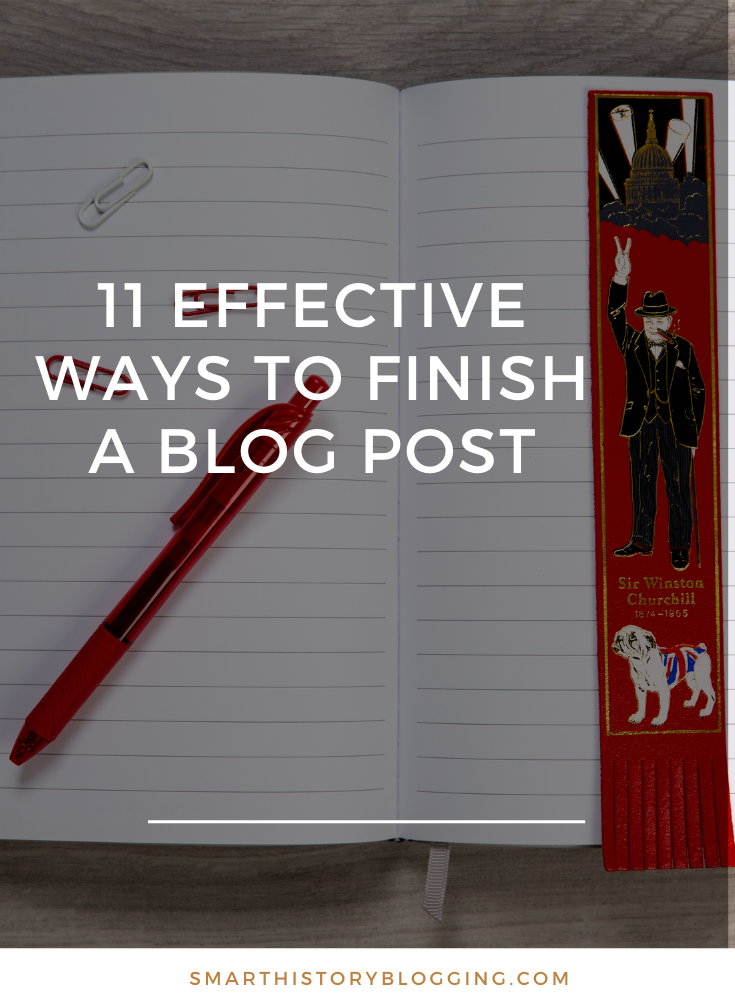Trying to finish a blog post can sometimes be the hardest part. You get in the writing flow, you’ve hit that sweet spot of 1500 words then wham! – how do I end? It’s tempting to just stop on your last point and hit publish isn’t it. But, doing that may mean you and your readers are missing out.
Here are 11 effective ways to finish a blog post to squeeze the most out of your final sentences and oh so gently guide your reader to what you want them to do next.

ONE: Inspire your readers
History blogs are the perfect place to inspire others. Perhaps you’re writing about that spectacular exhibition, non-fiction book, online talk, TV series, new podcast or dream historic location you’ve visited.
Finish your blog by encouraging your readers to book that trip, read a history book, watch that show or listen to that podcast because you think they’ll love it too. And, of course you want them to tell you all about it.
TWO: Ask your readers a question
You can casually ask “tell me what you think” or “let me know how you got on” in the comments but also try specific questions such as “Do you think it was right to execute Mary Queen of Scots?” You could also add a poll either on your blog or a cross-over onto social media as part of your promotion.
THREE: Ask your readers to share the post
Sometimes people will help us out just because we ask. So, don’t be shy about asking readers, who were so engaged with your post that they got to the bottom, to share it. Then, crucially, make it as easy as possible. Don’t overcomplicate things. Based on where you’re trying to grow your social media ask them to do one thing like “If you enjoyed this post please share it on Twitter.”
FOUR: Let them know about your next post
Creating a history blog series has lots of time-saving and promotional benefits but it also helps you end a post. If you’re covering the seven wonders of the ancient world tell them about your next wonder. If you’re just starting your series and it’s not fully written yet use another temporary way to finish your blog post then go back in and edit.
RELATED LINK: 35 Ideas for History Blog Posts
FIVE: Ask if they agree with you
If you’ve written a post about a mystery, conspiracy theory or case of injustice and offered up your opinion on events then it is a natural end to ask if a reader agrees with you. This can also be specific “Do you agree with me that the first moon landing was faked?” This shows passion for your topic, that you’re genuinely interested in what readers think and want to interact.
SIX: Tell them about other posts
If you’ve got a great archive then flaunt it!
You can provide a few links and say “If you liked this post continue the story with [insert linked post title]” or “Looking to broaden your knowledge? Try [insert linked post title]” or “Want to delve a bit deeper? You’ll enjoy [insert linked post title]”
Also, if you have created blog categories on your site direct them to your landing page. “Enjoyed this? Check out all my posts on Emmeline Pankhurst [add link to blog category page].”
SEVEN: Offer a useful related opt-in or freebie
If you’re starting or growing an email list using your blog posts is crucial. But, this should still be done in a related and useful way with the reader in mind.
As an extra tip, work backwards in your post planning. If the aim of your post is to signpost readers into your email list through a freebie about ‘The Top 10 Historic Attractions in Berlin’ write a post about the history of Checkpoint Charlie as a natural seamless way of promoting the opt-in at the end.
EIGHT: Set your reader a challenge
Can you challenge your reader in some way based on the content of your post? For example, I created a post showing step-by-step how to add email marketing into a history blog. I finished the post by asking reader’s to try it for themselves.
You could ask your reader to explore an alternative writer like you have or a lesser known figure from their history niche. Or maybe challenge them to discover authors from underrepresented groups or watch a TV program and see if they can spot twenty historical inaccuracies! : )
NINE: Do a summing up to finish a blog post
A bit like a school essay you can do a summing up. Add in a few sentences telling readers what they’ve just read.
You could combine this with another ‘call to action’ in this list.
TEN: Sell something
You don’t want readers to think you’re only posting to sell something and it certainly shouldn’t be a tool used every time. But, some blogs are businesses too. Just make sure there is a clear relevance or benefit to your reader like a discount. For example, don’t try and sell them an iPhone at the end of a post about Ancient Rome!
ELEVEN: Create a cliffhanger or teaser
You know when they do that TV voiceover thing “Next time on The Tudors…” which is usually followed by snippets of someone about to be executed and King Henry both losing his temper and bedding his latest conquest. Well, in blogging terms you’re trying to create one of those to get your readers to “tune in next week for….” But, unlike suggestion four this post doesn’t exist yet.
You could also capture people by asking them to sign up to a feature on your site so they never miss a blog post. This way you’ll be sending them the next instalment rather than relying on the reader to remember to come back to you.
So, now it’s your turn…
Here are the eleven ways to finish a blog post again:
- Inspire your readers
- Ask your readers a question
- Ask your reader to share the post
- Let them know about your next post
- Ask them if they agree with you
- Tell them about other posts
- Offer a useful related opt-in/freebie
- Set your reader a challenge
- Do a summing up
- Sell something
- Create a cliffhanger or teaser
All eleven ways to finish a blog post are about telling your reader in a nice helpful way what you would like them to do next, signposting them to a place of benefit to you and preventing a dead end on your post which also assists search engine listings.
So, wrapping up, and in the spirit of being a beacon of good practice : ) if you’re looking to make your history blog post planning easier checkout ‘The Ultimate History Blogging Planner’, available in print and digital versions (example below) there are unique history blogging templates to plan out your next post from start to finish.




